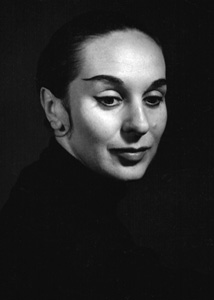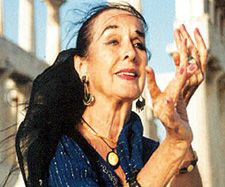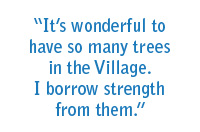 Dancer Vija Vetra was born in Riga, Latvia in 1923 and has been a WestBeth resident since 1970. Ms. Vetra has travelled the world as a solo dancer specializing in various styles, from modern to Indian. Since 1990, she has returned every year to her native country to teach master classes at the national theatre, receiving from the government the Award of Three Stars, their highest civilian honor.
Dancer Vija Vetra was born in Riga, Latvia in 1923 and has been a WestBeth resident since 1970. Ms. Vetra has travelled the world as a solo dancer specializing in various styles, from modern to Indian. Since 1990, she has returned every year to her native country to teach master classes at the national theatre, receiving from the government the Award of Three Stars, their highest civilian honor.
When Vija Vetra was growing up in her native Riga, music and dance were inextricably woven together. “Since I can remember, whenever I heard music I reacted to it with dance and movement. Music is very potent in my life and I always liked to move to it. The first instrument I danced to was the guitar because my father played it.”
It was after seeing a local production of Swan Lake that she decided she wanted to study dance professionally. But her family was against it. “So I ran away to Vienna to live with my aunt,” she says. “I was 16. She also didn’t want me to become a dancer, so I had everyone against me. I knew what I wanted, though. I knew it was my destiny. You either know it or you don’t.” Vetra did indeed study dance in Vienna. However, WWII began and the intervening years were a struggle for her and her family.
When the war ended, Vetra emigrated to Australia with her sister, mother, and aunt. She lived there for 16 years, opening her own studio, starting her own dance group, and even having her own television program. “I was very well known in Australia,” she recalls. In 1964 she was invited for a coast-to-coast dance tour of America and Canada. “I danced in 36 cities,” she says. “Then I was asked to be on the faculty at Carnegie Hall so I never returned to Australia. I opened my first studio in New York on Sixth Avenue and my second in Westbeth in 1970, where I still live.”

What does it feel like for her to dance? “It’s very special,” Vetra says. “It’s a feeling of not being the everyday person that I am, but that I connect with something higher above me. The best way to put it is I am not a pedestrian anymore, but I grow wings and I fly.” She feels strongly that dance has a healing power as well. “Any art form can be therapy,” she says. “But dance has healing power not only for the one who dances but also for the one who looks at it. That, too, is very important. And I’m not talking about much of what happens now in dance, which is deranged art. That does not heal!” she says emphatically. “But a certain way of dance, a certain way of art which uplifts you, that heals. There’s a big difference!”
As a resident of the West Village for over four decades, Vetra misses the “intimate” nature of what the Village used to be. “Bleecker Street has changed so much,” she laments. “It had these nice little boutiques, very nice restaurants, and mom and pop shops. Now it’s become so commercial, with high fashion boutiques that can be found anywhere.” However, she feels it remains the place to be if you live in New York. “I still love the Village much more than I do New York proper. When I go to midtown, I don’t feel like I’m home. But once I get off a bus in the Village, I do. It’s the best neighborhood in New York.”
 Vetra is particularly delighted with Hudson River Park. “It’s a wonderful place now,” she says enthusiastically. “I remember when it was those terrible wharfs. We went there on Sundays anyway, but it was very dangerous. Now what they’ve done on the riverside is fantastic! I really feel like I’m on the Riviera when I go there. It’s a great gift to the Village.”
Vetra is particularly delighted with Hudson River Park. “It’s a wonderful place now,” she says enthusiastically. “I remember when it was those terrible wharfs. We went there on Sundays anyway, but it was very dangerous. Now what they’ve done on the riverside is fantastic! I really feel like I’m on the Riviera when I go there. It’s a great gift to the Village.”
The garden in St. Luke’s is also one of her favorite spots to relax and meditate. And, finally, there are her trees. “I love all those blooming white trees on our streets in spring,” she says. “I have a favorite one on Tenth Street and when I stand under it, I ask it to bless me. It’s wonderful to have so many trees in the Village. I borrow strength from them. In fact, the river, St. Luke’s, and my blooming trees are the places where I get in touch not only with nature but also with myself. After all, I’m part of nature as well, am I not?”
Photo: Vija Vetra, London, 1962
